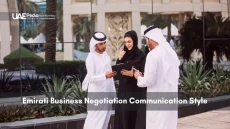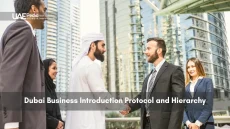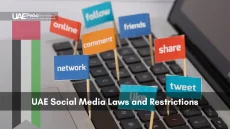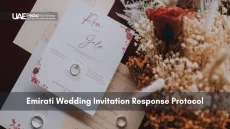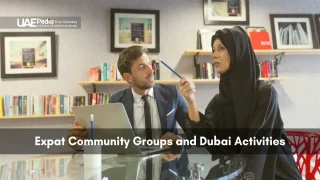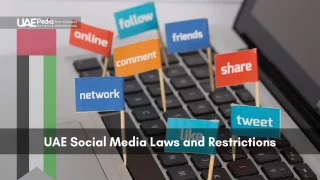What if the secret to thriving in global business wasn’t just what you say—but how you say it? In a city where skyscrapers meet centuries-old traditions, mastering the art of professional communication requires more than polished slides. It demands cultural fluency.
Here, business success hinges on balancing modern innovation with deep-rooted values. Understanding formal protocols—like prioritizing relationship-building over rushed deals—can transform your approach. A single misstep in tone or timing might overshadow even the strongest proposal.
This is where specialized training shines. Programs like the ceremony and etiquette protocol course equip professionals with actionable insights. You’ll learn to navigate unspoken rules, from appropriate greetings to structuring presentations that respect local sensibilities.
Key takeaways for your next meeting:
- Align your speaking style with formal hierarchies common in UAE business culture
- Use strategic pauses to invite collaboration without losing authority
- Adapt storytelling techniques to bridge cultural perspectives
We’ll walk through practical strategies that honor tradition while driving modern results. Because here, the right words open doors—but the right delivery builds empires.
Understanding the Dubai Business Landscape
Picture a marketplace where Bedouin hospitality shakes hands with blockchain innovation. The Emirates’ professional world thrives on contrasts—ancient trade routes reimagined as digital highways. To succeed here, you’ll need more than spreadsheets. You’ll need cultural compass points.
The Rhythm of Respect and Relationships
Islamic values pulse through daily interactions like a heartbeat. Business moves at the speed of trust here. Expect tea before contracts, family names before job titles. One local CEO puts it best: “We don’t just sign deals—we build bonds that outlive quarterly reports.”
| Traditional Practice | Modern Adaptation | Key Insight |
|---|---|---|
| Personal majlis meetings | Hybrid video conferences | Tech complements tradition |
| Formal Arabic greetings | Global English fluency | Language bridges cultures |
| Hierarchical approvals | Streamlined processes | Efficiency meets protocol |
Navigating the Ladder of Decision-Making
Hierarchy here isn’t about red tape—it’s about honoring experience. Senior executives often make final calls after team consensus. Pro tip: When presenting to mixed groups, address the highest-ranking member first while acknowledging others.
Abu Dhabi’s influence shapes regional standards, blending Gulf heritage with global ambitions. For those planning their market entry strategy, remember: Local partnerships often smooth the path better than going solo.
- Begin meetings with light conversation about family or health
- Use formal titles until invited to do otherwise
- Pause frequently for questions during presentations
Preparing Your Presentation and Conference Participation
Imagine your slides glowing against a screen while desert light filters through floor-to-ceiling windows. Here, every detail—from your opening line to your cufflinks—speaks before you do. Let’s craft a presentation that dazzles and respects local expectations.
Start with research beyond statistics. Know your audience’s values: Which family names matter? What historical references resonate? A local CEO once told me: “We listen to how you honor our story before we hear your spreadsheets.”
Three golden rules for structuring content:
- Lead with shared goals, not demands
- Use visuals of regional landmarks alongside data charts
- Replace slang with clear, respectful language
Sync your communication rhythm with local preferences. Pause every 7-10 minutes for questions—it shows you value dialogue over monologue. Time management is key: Emirati professionals prize strict time awareness. Keep sessions under 45 minutes, leaving space for relationship-building.
Your active part in success? Prep like a diplomat:
- Rehearse formal titles and pronunciations
- Plan outfit details (pro tip: conservative dress code earns trust)
- Arrive early to test tech setups—power outlets here use Type G plugs
For those navigating visa logistics, our guide to UAE immigration processes simplifies paperwork hurdles. Remember: Your best slides mean nothing without cultural fluency lighting up the room.
Mastering the Art of Small Talk at Professional Events
Ever notice how the right casual remark can unlock doors faster than a vault code? In cross-cultural hubs, light conversation isn’t filler—it’s the golden thread weaving trust through first impressions. Research shows 73% of professionals consider thoughtful small talk crucial for building rapport before business discussions.
Start with open-ended questions that invite stories, not yes/no answers. Try: “What brought you to this event?” or “How’s your experience with the venue?” One local entrepreneur shared:
“We listen for genuine interest—not just rehearsed compliments.”
| Safe Topics | Risky Topics | Pro Tip |
|---|---|---|
| Regional cuisine | Politics | Ask about favorite dishes |
| Travel experiences | Personal finances | Share memorable trips |
| Cultural festivals | Religion | Celebrate shared traditions |
When addressing men and people from varied backgrounds, balance eye contact without intensity. Nod slightly to show engagement. If conversation lulls, pivot to neutral ground—recent industry trends or innovation wins work well.
Remember: A 2-minute chat about date palm harvesting techniques might reveal more common ground than an hour of slides. These moments build bridges from “hello” to “let’s collaborate”—one genuine exchange at a time.
Applying “dubai conference participation speaking etiquette” in Your Interactions
Ever watched a simple gesture turn strangers into collaborators? In cross-cultural exchanges, your physical cues often speak louder than PowerPoint slides. Let’s decode the silent language of professional respect.
Start with the right hand rule. In local customs, this hand symbolizes trust and cleanliness. Use it exclusively for:
- Exchanging business cards
- Handshakes
- Accepting refreshments
“Your first gesture sets the tone—like a firm handshake paired with eye contact. It says, ‘I see you as an equal partner.’”
| Proper Gestures | Common Pitfalls | Quick Fix |
|---|---|---|
| Light handshake (2-3 seconds) | Overly tight grip | Practice with a colleague |
| Right hand on heart after greeting | Using left hand accidentally | Keep items in left pocket |
| Open palm gestures | Pointing fingers | Use whole hand to indicate |
Building relationships here thrives on consistency. A client once shared how remembering their preferred tea order led to faster contract approvals. Small acts compound.
Avoid these missteps:
- Checking your phone during introductions
- Standing too close (arm’s length ideal)
- Forgetting to greet senior members first
Do it the right way, and watch barriers dissolve. One executive landed a deal by mirroring her counterpart’s measured nod rhythm. Your body speaks—make every move a bridge.
Dress Code Essentials for Business Success
Your clothing speaks before you do—a silent language of respect in professional spaces. Getting it right builds instant credibility. Here’s how to align your wardrobe with local expectations while maintaining personal style.
Men’s Attire: Precision Meets Tradition
Tailored suits in neutral tones (charcoal, navy) work for formal meetings. Many local executives wear crisp kandoras—the white ankle-length robe—paired with leather loafers. Grooming matters:
- Trimmed beards or clean-shaven faces
- Minimal cologne (opt for fresh citrus scents)
- Polished shoes without flashy buckles
Women’s Wardrobe: Elegance Through Modesty
Think tailored blazers over knee-length skirts or trousers. Shoulders and chest areas stay covered—flowing abayas with intricate embroidery strike a balance between tradition and modernity. One designer notes:
“Layering is key. A silk scarf can transform a basic dress into culturally appropriate attire.”
| Formal Settings | Smart Casual | Avoid |
|---|---|---|
| Closed-toe heels | Pashmina wraps | Sheer fabrics |
| Full-sleeve blouses | Tailored jumpsuits | Low necklines |
| Luxury watches | Structured handbags | Excessive jewelry |
Three universal rules:
- Knees and shoulders covered at all times
- Clothing should skim the body without clinging
- Natural fabrics combat heat while looking polished
Remember: Dressing well isn’t vanity—it’s visual respect. Nail this, and you’ll find doors opening faster than you can say shukran.
Building Professional Relationships Through Respectful Communication
What’s the invisible thread that turns a handshake into a partnership? It’s the art of how you greet, not just whom you meet. In cross-cultural settings, your opening moments set the stage for every conversation that follows.
First Impressions That Stick
Local professionals often recall greetings longer than business pitches. A regional HR director shares:
“We remember if someone waited patiently for elders to speak first—it shows they value our customs.”
This principle applies to card exchanges too. Always present yours with yourright hand, face-up, while making brief eye contact.
Three golden rules for initial encounters:
- Let senior members extend their hands first
- Keep handshakes firm but brief (2-3 seconds)
- Use open palm gestures when speaking
| Ideal Practice | Common Mistake | Quick Adjustment |
|---|---|---|
| Gentle hand pressure | Overly vigorous shaking | Practice with a colleague |
| Standing at arm’s length | Invading personal space | Mark your spot subtly |
| Brief nod while greeting | Looking around the room | Focus on one person |
These details build trust silently. One tech founder landed a deal by remembering a client’s preferred Arabic coffee order from their first meeting. Small courtesies compound into lasting relationships.
Final tip: Mirror your counterpart’s energy. If they prefer a verbal greeting over physical contact, follow their lead. Adaptability speaks louder than any rehearsed script—and often opens doors no spreadsheet can.
Navigating Local Customs and Formal Meeting Protocols
Ever wondered why some meetings flow like Arabic coffee while others stumble? The answer lies in mastering two rhythms: clock time and relationship time. Here, schedules bend but never break—like desert palms swaying in harmony with the wind.
Understanding Punctuality and Flexibility
Arriving early shows respect. But rigid agendas? Not so much. A local project manager explains:
“We value your time—but we won’t rush trust-building for a timestamp.”
| Western Approach | UAE Adaptation | Why It Works |
|---|---|---|
| Strict 30-minute slots | Buffer periods between events | Allows organic dialogue |
| Immediate agenda start | 15-minute personal check-ins | Builds rapport first |
| Late = unprofessional | 10-minute grace period | Respects traffic realities |
Starting with Personal Conversation
Your first three minutes matter most. Try these icebreakers:
- “How was your weekend family gathering?”
- “Have you visited the new Louvre Abu Dhabi exhibit?”
- “What’s your favorite local spot for karak tea?”
Companies here often layer decisions like baklava—sweet but structured. Senior leaders finalize choices after team input. Pro tip: Note who defers to whom during casual chats—it reveals unspoken hierarchies.
Three norms to remember:
- Schedule morning meetings—afternoon heat slows everything
- Keep Fridays sacred (family/religious time)
- Confirm events twice—digital invites get lost in translation
Master this dance, and you’ll find the United Arab Emirates’ business culture opens like a well-timed majlis door—graceful, welcoming, and full of possibility.
Tips for Effective Non-Verbal Communication
Silence speaks volumes here—but are you fluent in its dialect? In cross-cultural exchanges, your posture often shouts while words whisper. Research shows 65% of meaning gets lost when body language clashes with speech.
Start with eye contact that says “I see you” without staring. Locals appreciate brief, warm glances during greetings—think sunlight flickering through palm fronds, not laser focus. A hospitality manager shares:
“We notice if someone’s gaze darts around the room. Steady attention shows respect for the person, not just the deal.”
| Positive Signals | Cultural Pitfalls | Quick Fix |
|---|---|---|
| Open palms facing upward | Pointing with index finger | Gesture with whole hand |
| Slight head tilt while listening | Crossed arms during negotiations | Rest hands lightly on table |
| Standing at arm’s length | Backing away during handshakes | Plant feet shoulder-width apart |
Your stance acts as a mood ring. Lean forward slightly to show engagement, but avoid invading personal space. When seated, keep both feet grounded—it signals stability. Mirroring others’ energy works wonders too. Did they nod twice after your proposal? Return the rhythm.
For those preparing deeper cultural immersion, our visa interview guide covers subtle cues inspectors might notice. Remember: Every shrug or smile becomes part of your silent résumé here.
Three rules to keep in mind:
- Let pauses breathe—don’t rush to fill silence
- Observe how locals greet elders first
- Practice neutral expressions before mirrors
Master this, and watch your unspoken words build bridges no translator could replicate. After all, the body never lies—it just needs the right dialect.
Adapting Your Presentation Style for Diverse Audiences
Ever felt your words land differently across a room of global minds? In the UAE’s crossroads of cultures, your slides might sparkle—but your delivery determines whether they ignite collaboration or confusion. Tailoring your approach isn’t just polite; it’s strategic.
Balancing Formality with Approachability
Think of your tone like serving Arabic coffee with a modern twist: warmth wrapped in precision. A communications director in Abu Dhabi advises:
“International teams expect data-driven clarity, while local partners value respectful storytelling. Blend both, and you become unforgettable.”
Three ways to harmonize styles:
- Open with a concise company overview using infographics, then share a personal anecdote about regional innovation
- Use formal titles initially, transitioning to first names only if invited
- Pause after key points—it invites reflection without pressure
| Formal Element | Approachable Twist | Impact |
|---|---|---|
| Structured agenda | Interactive polling questions | Engages quiet participants |
| Industry jargon | Analogies using local landmarks | Clarifies complex ideas |
| Scripted transitions | Spontaneous humor breaks | Humanizes the presenter |
One tip from tech leaders: Record practice sessions to spot stiffness. Watch for nodding rhythms—too rigid? Add a relatable metaphor. Too casual? Anchor with a statistic.
Your communication becomes the bridge when you balance authority with curiosity. Test styles, gather feedback, and refine. Because here, the right way of sharing ideas doesn’t just inform—it transforms.
Managing Time and Scheduling in a Dynamic UAE Business Environment
Time bends differently here—not slower or faster, but with intention. In the Emirates’ fast-paced markets, hours hold dual meanings: strict punctuality for formal meetings, fluid grace periods for relationship-building. A logistics manager shares:
“We start exactly at 10 AM—but the first 15 minutes? That’s for asking about your family’s health.”
Master these rhythms with smart planning:
- Color-code your day: red blocks for fixed appointments, green for flexible networking
- Book morning slots for decision-focused talks (energy peaks pre-noon)
- Leave 30-minute buffers between events—traffic surprises even locals
| Western Expectation | UAE Reality | Your Strategy |
|---|---|---|
| Back-to-back calls | Post-meeting tea rituals | Block “connection time” |
| Instant email replies | Patience with response gaps | Follow up twice weekly |
| Rigid deadlines | Flexible project timelines | Set soft milestones |
Midday heat reshapes schedules too. Many firms pause from 1-3 PM—use this for virtual tasks. Evenings buzz with activity once temperatures drop. Pro tip: Sync critical business dinners with cooler times (7 PM onwards).
Three signs you’re nailing it:
- You arrive five minutes early—not thirty
- Your calendar has breathing room for spontaneous majlis invites
- You never check your watch during someone’s story
Balance is key. Honor start hours, embrace organic flow. Because here, time isn’t money—it’s trust measured in shared moments.
Networking Strategies for Successful Business Engagements
True connection happens when business cards become bridges. In the Emirates’ buzzing hubs, networking isn’t just swapping LinkedIn profiles—it’s crafting shared stories that outlast elevator pitches. A tech founder once told me: “The best deals here start with a coffee chat about family recipes.”
Leveraging Industry Events and Cultural Gatherings
Chambers of commerce mixers and trade expos thrive on one rule: Listen first. Research shows 68% of professionals prefer collaborators who ask thoughtful questions over those pushing agendas. Try these approaches:
- Spot shared interests before mentioning services
- Exchange contact details via app scans (less intrusive than paper)
- Follow up within 48 hours with personalized references
| Effective Approach | Common Mistake | Pro Tip |
|---|---|---|
| Discussing regional sustainability goals | Dominating conversations | Use 60/40 listening ratio |
| Sharing local event insights | Forgetting names | Repeat them twice aloud |
| Offering helpful introductions | Overpromising | Connect two people max |
One logistics CEO landed a major contract by casually discussing date farming innovations at a cultural festival. Relationships here grow like desert roses—slowly, but with stunning results.
Key reminders:
- Attend niche expos like GITEX for tech or ADIPEC for energy
- Warm up cold approaches by mentioning mutual contacts
- Send post-event thank-you notes with meeting highlights
“We remember who stayed curious after the nametapes came off.”
Build bonds, not just contacts. Because here, your next big break might arrive through a shared laugh over karak tea.
Understanding the Intersection of Culture and Business Etiquette
Think of Emirati professional spaces as intricate tapestries—woven threads of Bedouin tradition and global ambition. Here, culture isn’t just background noise—it’s the blueprint for every handshake and negotiation. One logistics director shared:
“Our business etiquette mirrors our values: honor elders, value patience, and prioritize collective success over individual wins.”
| Cultural Root | Modern Practice | Why It Works |
|---|---|---|
| Desert hospitality customs | Pre-meeting coffee rituals | Builds trust pre-agenda |
| Family-first social structures | Extended contract review periods | Ensures group consensus |
| Islamic prayer schedules | Flexible meeting timings | Shows cultural awareness |
Three ways to blend business etiquette UAE standards with global norms:
- Swap firm handshakes for gentle grips during initial greetings
- Schedule critical discussions post-Ramadan for optimal engagement
- Use indirect language for feedback (“Perhaps we could explore…”)
Notice how business culture united Arab traditions with international expectations? Gift-giving offers another clue. While global firms avoid lavish presents, Emirati partners appreciate thoughtful tokens—dates from your hometown or artisanal notebooks.
True mastery lies in reading unwritten rules. A consultant recalled adjusting a pitch after noticing clients’ repeated references to sustainability—a core UAE vision. By aligning proposals with national values, she secured approval faster.
Remember: Understanding others means noticing pauses in conversation or preferences for formal titles. These nuances transform transactions into partnerships—one culturally attuned gesture at a time.
Final Thoughts on Embracing Dubai Business Culture
Navigating professional waters where golden sands meet neon skylines demands more than ambition—it requires cultural fluency. Your journey here thrives on blending timeless values with tomorrow’s opportunities. Remember: A thoughtful dress code isn’t just fabric—it’s visual respect woven into every thread.
In the United Arab Emirates, success blooms when you honor both tradition and innovation. Simple gestures—modest attire during Ramadan or discreet eat drink public habits—signal deeper understanding. These choices whisper, “I value our shared space.”
Three anchors for lasting connections:
- Let polished shoes mirror polished manners
- See pauses as invitations, not awkward silences
- Celebrate local wins as enthusiastically as your own
Every handshake here carries the weight of heritage and hope. By prioritizing others’ comfort through small courtesies, you build bridges no contract can replicate. The Emirates rewards those who listen with their eyes as much as their ears.
Ready to dive deeper? Explore UAepedia.net for insider guides that turn cultural curiosity into career momentum. Your next breakthrough isn’t just about what you know—it’s about how you grow where desert wisdom meets global ambition.
Avoid sleeveless tops, short skirts above the knees, or tight clothing. Opt for tailored trousers, blouses covering shoulders, or knee-length dresses. Scarves add modesty while keeping style—think "elegant professional" over trendy.
Wait for locals to extend their hand first, especially with women. Use your right hand always—even for passing documents. A slight nod or placing your right hand over your heart works if unsure.
Aim for 10–15 minutes early. While punctuality matters, some flexibility exists for senior executives. Use waiting time to review notes—delays aren’t personal, just part of the flow.
Steer clear. Stick to safe topics like UAE’s growth, travel, or cuisine. Compliment hospitality (“Your team organized this beautifully!”) or ask about local festivals. Listen more than lecture.
Lightweight suits in linen or cotton trump heavy fabrics. Ties? Skip them unless meeting government officials. Rolled sleeves are acceptable—just ensure collared shirts stay crisp.
Address them as “Sheikh” if they hold the title, followed by their full name. Present materials with both hands. Avoid aggressive eye contact—modest nods show attentiveness without intensity.
Use sparingly. Self-deprecating jokes work better than sarcasm. Test light anecdotes related to teamwork or innovation. Avoid slang—opt for universal stories that translate across cultures.
Rushing into business talk. Build rapport first—ask about family (generally), or praise the venue. Silence isn’t awkward here; it’s a sign others are processing ideas thoughtfully.





